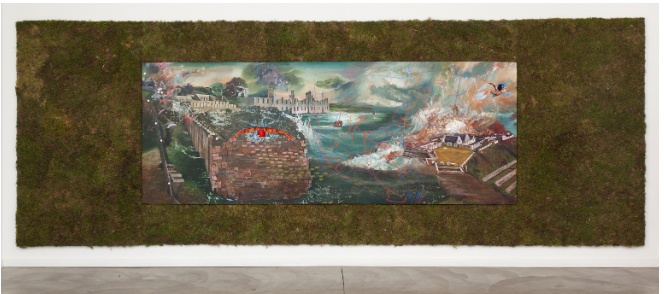
Gathering Moss
This is artist Melissa Furness and this area of the exhibition continues some of my project-based pieces, along with works that explore ideas about how nature reclaims what man creates over time. There is that saying that "a rolling stone gathers no moss". It is about having no roots with these pieces.
There is intrigue with the polar opposite, perhaps having so many roots so as to be overtaken by them, swallowed up by the overgrowth. These pieces explore how nature has the power to change history, eat part of it up so that the narrative of history is altered as humans struggle to find our roots while becoming wrapped up in the stuff of status and responsibilities.
Okay, stemming from the previous space and into the two alcoves of this space is a project-based piece that I did for the Biennial of the Americas in 2015. This summer marks the 10 year anniversary of that piece, which was part of a residency exchange where I was selected to live in Mexico City for 10 weeks and produced a project based off of my experiences there. This resulted in the creation of 315 paintings and 100 drawings, which I compiled to create my own epic ruin, which was a cross between a pyramid and a trash pile. So you can learn more about this project by taking a look at the book that I created and reading some of the associated narratives that describe this.
Part fictional, part real, historical, contemporary ruin, the individual paintings in this pile that I created are based off of a, for the format of an ex-voto, which is an offering of a painting or sculpture created by a folk artist, given as a gesture of gratitude or devotion to a deity or a saint typically in fulfillment of a vow or after a miracle is received. So these ex-voto paintings are highly dramatic and very personal. I myself wrote a journal about my experiences in Mexico City and then created this series of quick paintings based off of my experiences and presented them in the format of the ex-voto as an offering of myself to this place.
Built into this project was additionally this idea of the game of telephone where I took my writing and put it through a purposefully bad Spanish translator, wrote it in pencil in cursive, and had my assistant who doesn't know cursive, trace the pencil line so that when a native Spanish speaker reads back the fragments of the text, they become distorted and symbolic of my limited time there and my efforts to root myself in this place. I eventually installed this self-made ruin onsite and let it weather for seven months before removing the paintings from their stretchers and reconfiguring them in the way that you see them here. So many of these works are based off of a sense of location while combining immediate experiences with those that have been absorbed previously. These works are a process of transformation. The transformation of the art objects that one produces, as well as one's own, you know, transformation of experience.
Another series of works in this space involve a video, the tapestry next to it, as well as the photographs of the hand drawn and painted raw linen embedded into the landscape. These pieces originated with a work done on site and county Kilkenny, Ireland. I invite you to watch the video for more information about this project. The tapestry is a restored version of the original piece created on raw linen, which lived on site for about a month and was shipped back to me. Parts had been completely eaten away, and so I transformed the pieces into this tapestry and presented as a museum artifact. With much of my work, I make something of a study of museums and seek to question how we as people are expected to relate to a past that we have become so removed from. We go to the museum and see a rock or a fragment of a thing in a box and are told that it is important viewing it, with this odd sense of remove. So to me, the museum also plays this game of telephone with the past, attempted to translate history for us without really knowing how it is received.
I am interested in the life of the art object, its history, as well as how it transforms over time with human interaction. The large moss piece with the painting embedded was the first piece that I created using nature in this way. It was quite an ordeal to create the panels, but the moss is real. It is a dried sheet moss, which has stood the test of time. The painting is based off of the historical genre of history painting. I created my own type of history painting depicting an invented narrative of my own. History painting was once considered the highest and most important form of painting, valued for its ability to educate and inspire audiences with this piece and those like it.
In the section of the exhibition that focuses on ruins, I was interested in taking these elevated public themes and making them personal or private with a moss surrounding to consume the grand history and transform it into something more individual.